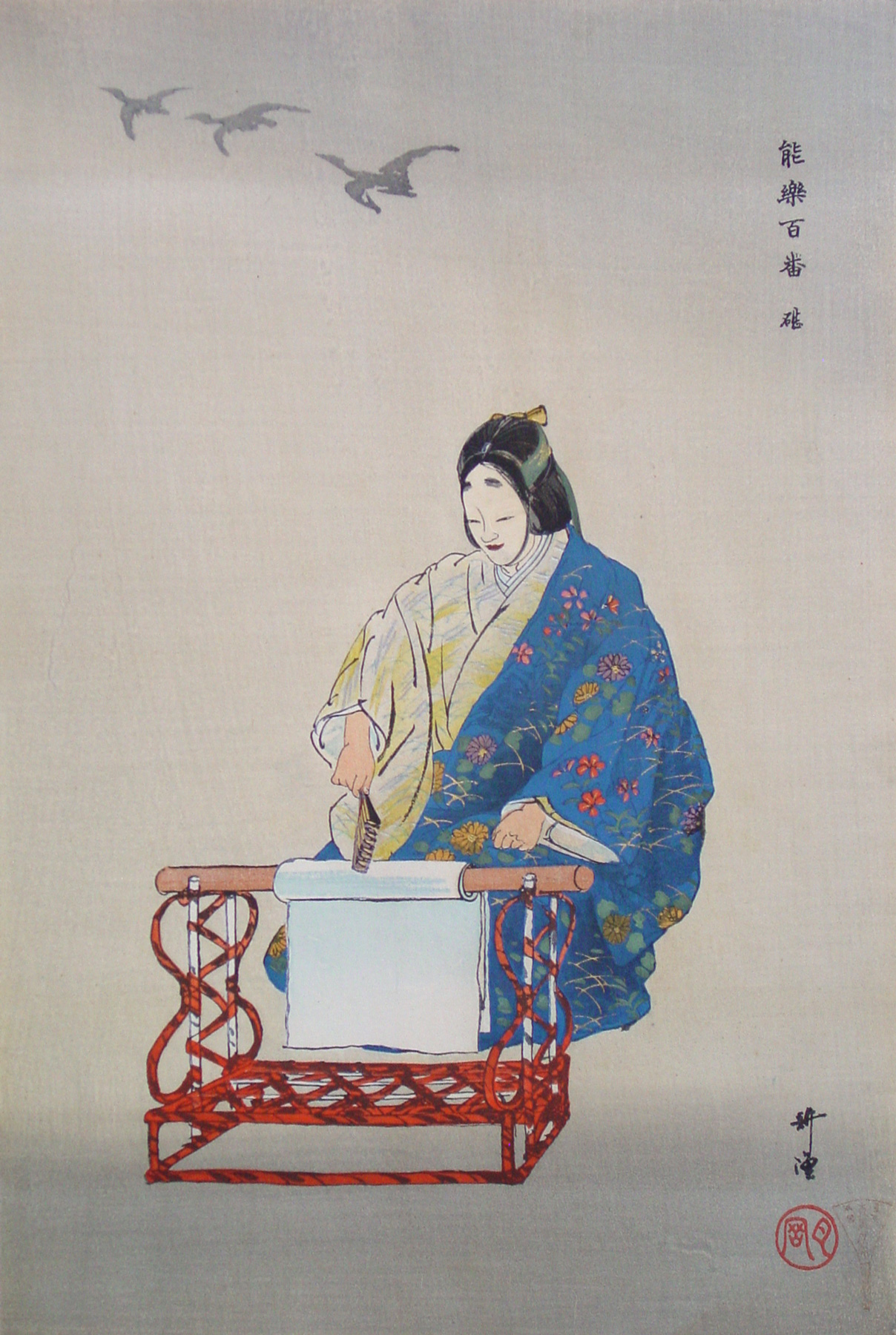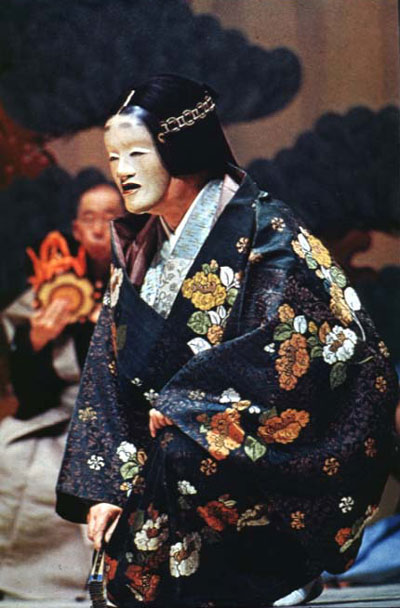About This Print
One of 120 prints issued as part of the series Nōgaku hyakuban (One Hundred Prints of Noh), it depicts a scene from the play Kinuta by the playwright Zeami Motokiyo (1363-1443) in which the wife beats the household fabrics rhythmically with a fulling block1 in the cool autumn evenings to pass the time in her sadness.2 This print was originally released by the publisher Matsuki Heikichi in the fourthinstallment of prints in this series. This series' prints were offered in monthly installments consisting of three prints packaged in an envelope with additional descriptive information.3The Play - Kinuta (The Fulling Block)
Source: Hirotakansyokai website http://hirota-kansyokai.la.coocan.jp/eibun/images/4kaiKinuta.pdfKinuta is an example of the “revengeful ghost” type of Noh play. It deals with the inordinate love of a wife for her husband both in life and after death.
The heroine of the play is the wife of a feudal lord of Kyushu, the Lord of Ashiya. He has been up to Miyako for three years for the purpose of bringing a lawsuit, and his wife is left alone, longing for his return. Feeling uneasy about his wife at home, he sends the family maid back with a message to his wife that he is unable to return until the end of the year. She is grieved at the news and speaks a few words of regret and reproach to the young messenger, as she suffers from the apprehension that he might have changed his mind. Yet the thought that she might soon meet him revives her hope. In the stillness of the autumn night, she hears far-away sounds of women beating cloth on a cloth-block for producing a high luster. She remembers the ancient tale of Sobu, who, as envoy at a faraway region, beat cloth at night in the hope that the sounds would carry his love and tenderness to his wife and children left at home. She starts beating cloth. The sounds of beating cloth, the night wind, the sorrowful voices, and the chirping of insects intensify her loneliness and grief, and build up the atmosphere of poetic beauty.
But to her sorrow and bitterness, another messenger arrives to say that her husband is unable to fullfil his promise of returning at the end of the year. Her remaining hope is crushed; she mistakenly believes herself abandoned, becomes ill and eventually dies.
Hearing of her death, the Lord of Ashiya hurries home. He laments the death of his wife and regrets his ungratefulness towards her. He performs at home a birch-bow ritual to call up his wife’s spirit in order to express his apology. His wife appears as a ghost and unburdens herself to him of all her complaints, but at the same time describes the torments of Hell she deserves, because she died of jealousy and resentment. Soon, however, the chanting of the Lotus Sutra transforms her agony and grief into knowledge and enlightenment, and released from sufferings, she finds eternal rest. (summary by Takao Saijo)
1 Fulling blocks are wooden mallets used during the Edo period to beat the washing to get it dry and soft. They also gave a special shine to the beaten cloth. The cloth was hit on a wooden block or on stone, sometimes near the river where the washing was done. "Pounding cloth" is another translation of this activity.
2 The International Shakuhachi Society website http://www.komuso.com/pieces/Kinuta_Sugomori.html
3 “The series Nogaku hyakuban (100 No plays) by Tsukioka Kogyo (1869-1927),” Claus-Peter Schulz, Andon 67, Society for Japanese Arts, p. 28.
1969 performance of Kinuta
Copyright 1998-2008, Global Performing Arts Consortium. All Rights Reserved.
Print Details
| IHL Catalog | #267 |
| Title | Kinuta 砧 (The Fulling Block) |
| Series | Nōgaku hyakuban 能楽百番 (One Hundred Prints of Noh or One Hundred Noh Plays) |
| Artist | Tsukioka Kōgyo (1869-1927) |
| Signature | Kōgyo |
| Seal |  Tsukioka, seal no. 1, p. 170 in The Beauty of Silence: Nō and Nature Prints by Tsukioka Kōgyo (1869-1927), Robert Schaap & J. Thomas Rimer, Hotei Publishing, 2010. Tsukioka, seal no. 1, p. 170 in The Beauty of Silence: Nō and Nature Prints by Tsukioka Kōgyo (1869-1927), Robert Schaap & J. Thomas Rimer, Hotei Publishing, 2010. |
| Date | October 1922 |
| Edition | unknown |
| Publisher | Matsuki Heikichi (Daikokuya) |
| Carver | |
| Impression | excellent |
| Colors | excellent |
| Condition | excellent - not backed or trimmed |
| Genre | nishiki-e; nōgaku zue 能樂圖繪 [Noh play picture] or 能絵 [Noh-e] |
| Miscellaneous | |
| Format | oban tate-e |
| H x W Paper | 14 7/8 x 10 in. (37.8 x 25.4 cm) |
| Collections This Print | Scripps College 2007.1.10; Los Angeles County Museum of Art AC1997.254.22 |
| Reference Literature |



